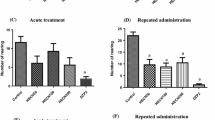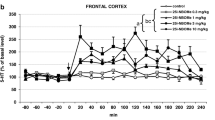Anticompulsive activity of a novel compound GIZh-72 (4,6-dimethyl-2-(4-chlorphenyl)-2,3-dihydro-1H-pyrazolo[4,3-C]Pyridine-3-on, chloral hydrate) in a dose of 20 mg/kg (single, subchronic, and chronic administration) in comparison with fluvoxamine (25 mg/kg) was studied in the marble burying test in the model of unpredictable chronic mild stress on BALB/c mice. GIZh-72 produced an anticompulsive effect that increased with increasing treatment duration under stress conditions in contrast to fluvoxamine that induced inversion of this effect after long-term administration. Neuroleptic activity of GIZh-72 in doses of 20 and 40 mg/kg was studied on the model of apomorphine-induced climbing in C57Bl/6 mice. In contrast to haloperidol (0.5 mg/kg), GIZh-72 exhibited no neuroleptic properties. Our results indicate that GIZh-72 holds much promise for pharmacotherapy of obsessive-compulsive disorder.
Similar content being viewed by others
References
Kudryashov NV, Kalinina TS, Voronina TA. Unpredictable chronic mild stress effects on antidepressants activities in forced swim test. Ross. Fiziol. Zh. 2015;101(2):163-170.
Seredenin SB, Voronina TA, Glozman OM, Zhmurenko LA, Molodavkin GM, Meletova OK. Patent RF No. 2394034. Derivatives of 4,6-dimethyl-2,3-dihydro-1H-pyrazolo[4,3-c]pyridine-3-ones and ethers 2,6-dimethyl-4-phenyl-hydrazine nicotinic acids as intermediate products for their synthesis, possessing antidepressant and anxiolytic potency. Bull. No. 19 (July 10, 2010).
Manual for Preclinical Studies of New Pharmacological Substances, Mironov AN, Bunatyan ND, eds. Moscow, 2012. Russian.
Animal and Translational Models for CNS Drug Discovery. Volume 1. Psychiatric Disorders, McArthur RA, Borsini F, eds. New York, 2008.
Boileau B. A review of obsessive-compulsive disorder in children and adolescents. Dialogues Clin. Neurosci. 2011; 13(4):401-411.
Borsini F, Podhorna J, Marazziti D. Do animal models of anxiety predict anxiolytic-like effects of antidepressants? Psychopharmacology (Berl). 2002; 163(2):121-141.
Bruins Slot LA, Bardin L, Auclair AL, Depoortere R, Newman-Tancredi A. Effects of antipsychotics and reference monoaminergic ligands on marble burying behavior in mice. Behav. Pharmacol. 2008; 19(2):145-152.
Decloedt EH, Stein DJ. Current trends in drug treatment of obsessive-compulsive disorder. Neuropsychiatr. Dis. Treat. 2010; 6:233-242.
Heisler LK, Pronchuk N, Nonogaki K, Zhou L, Raber J, Tung L, Yeo GS, O’Rahilly S, Colmers WF, Elmquist JK, Tecott LH. Serotonin activates the hypothalamic-pituitary-adrenal axis via serotonin 2C receptor stimulation. J. Neurosci; 27(26):6956-6964.
Hill MN, Hellemans KG, Verma P, Gorzalka BB, Weinberg J. Neurobiology of chronic mild stress: parallels to major depression. Neurosci. Biobehav. Rev. 2012; 36(9):2085-2117.
Ichimaru Y, Egawa T, Sawa A. 5-HT1A-receptor subtype mediates the effect of fluvoxamine, a selective serotonin reuptake inhibitor, on marble-burying behavior in mice. Jpn J. Pharmacol. 1995; 68(1):65-70.
Marazziti D, Carlini M, Dell’Osso L. Treatment strategies of obsessive-compulsive disorder and panic disorder/agoraphobia. Curr. Top. Med. Chem. 2012; 12(4):238-253.
Rosso G, Albert U, Asinari GF, Bogetto F, Maina G. Stressful life events and obsessive-compulsive disorder: clinical features and symptom dimensions. Psychiatry Res. 2012; 197(3):259-264.
Veale D, Roberts A. Obsessive-compulsive disorder. BMJ. 2014; 348):g2183. doi: 10.1136/bmj.g2183.
Witkin JM. Animal models of obsessive-compulsive disorder. Curr. Protoc. Neurosci. 2008. Chapter 9: Unit 9.30. doi: 10.1002/0471142301.ns0930s45.
Author information
Authors and Affiliations
Corresponding author
Additional information
Translated from Byulleten’ Eksperimental’noi Biologii i Meditsiny, Vol. 161, No. 3, pp. 355-358, March, 2016
Rights and permissions
About this article
Cite this article
Kudryashov, N.V., Kalinina, T.S., Zhmurenko, L.A. et al. Anticompulsive Activity of a New Pyrazolo[C]Pyridine Derivative GIZh-72 under Conditions of Unpredictable Chronic Mild Stress. Bull Exp Biol Med 161, 377–380 (2016). https://doi.org/10.1007/s10517-016-3418-y
Received:
Published:
Issue Date:
DOI: https://doi.org/10.1007/s10517-016-3418-y




